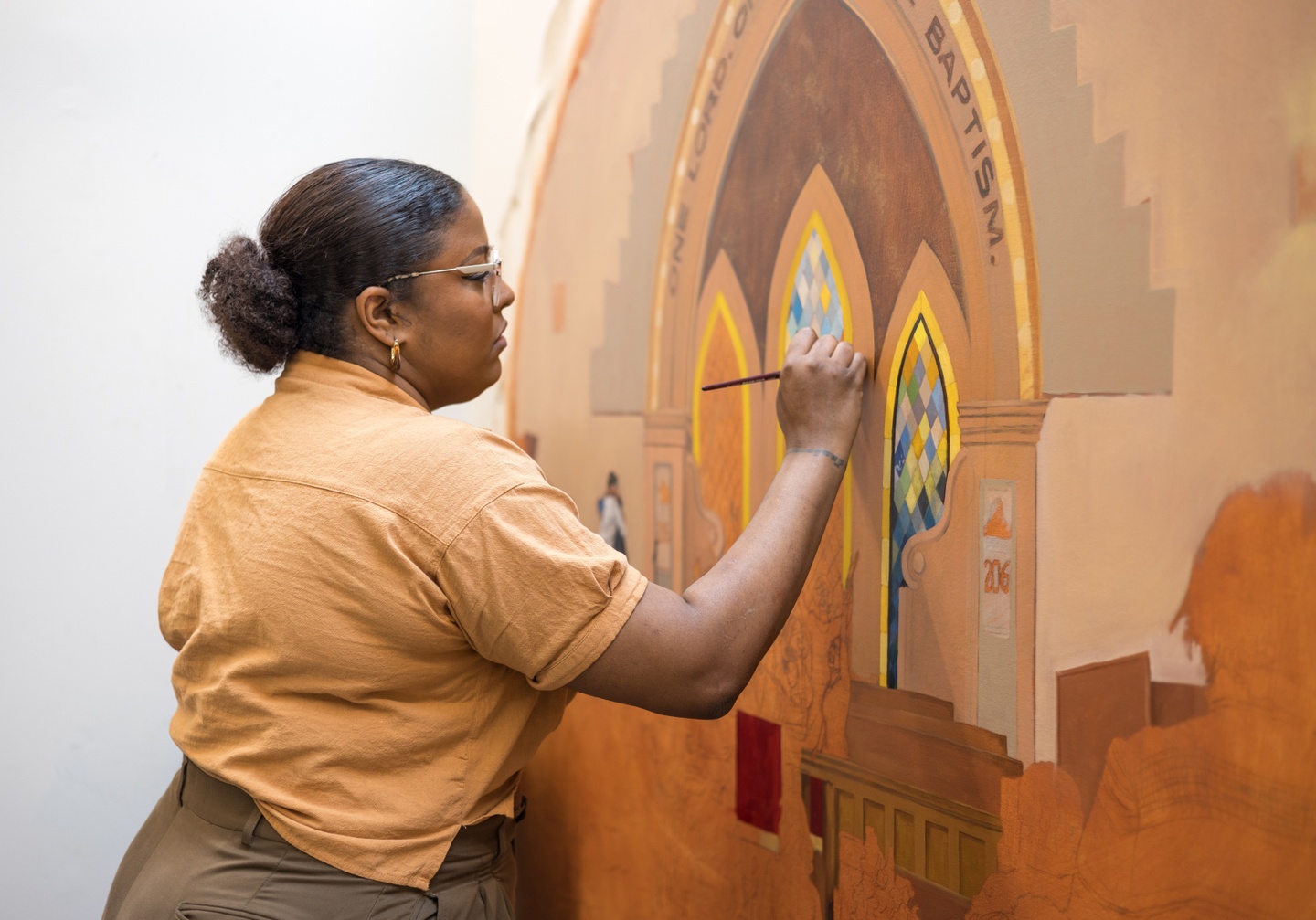Q&A with Jamie Lee Harris
Jamie Lee Harris earned her BA from Alabama State University. She was born and raised in Notasulga, Alabama. She received National Black Arts Festival’s 2021 Horizon Award. Harris uses her works as a means of historical storytelling and healing.
Jamie Lee Harris, Maame Wata Awaits for You, Ma, 2023. Ceramic, terracotta, sand, wood, and copper. Dedicated to Tammy Harris (September 6, 1961–August 16, 2022)
Jamie Lee Harris in her studio (Photo: Caitlin Custer)
Tell us about your project.
My thesis project is primarily focused on the mourning history of the African diaspora. With this research, I’m looking at different African religions and searching for common threads between a Western lens and an African lens. I’m looking for elements that resonate with me and speak through my work.
I lost my mom to cancer in August, so that cemented this project for me. It’s a very large painting and a 6’1’’ sculpture — that’s her height. It’s kind of an homage to her and the family members I’ve lost since I’ve decided to go back to school and pursue art.
How has the experience been processing all this while making art?
Cathartic. It’s been a labor of love, lots of labor, lots of crying, lots of processing. I think it has helped some of the healing and the aftermath. I didn’t really get an opportunity to sit down and process, so I’ve used this as kind of an emotional transition for her passing and being in memoriam.
How did you and your mom relate about you as an artist?
Oh, it was a huge struggle. I got art scholarships in high school and did a lot of traveling and fellowships to figure out what I wanted to do. I turned down everything because my family is staunch on education. You’re either an educator, a nurse, or in the military. For the girls in the family, it was nursing. We come from a very small little town in Alabama — making sure that we had the opportunity to get beyond that area was a big deal. In their minds, art was not the way to make that happen. But I started doing pop-up shows, work started selling, and then they realized, “OK, this might be a thing!”
What drew you to art in the very beginning?
As a small child, I would carve into the wood furniture, paint things, put nail polish on the walls. My mom kept a small sketch of this baby doll that I painted with glitter; it was one of the things she had in my first portfolio she put together for me.
I was always doodling and sketching in the middle of class. My math teacher in high school called me out and pulled me aside and said, “hey, I’ve been looking into these art competitions in the area, you should try doing something for one of them.” My school didn’t have an art teacher and we only had three art books: Da Vinci, Michelangelo, and Picasso. I started by doing copies of those.
When I finally went to college, I decided to go into veterinary medicine. I lost interest in that and withdrew, took a break, and worked in health care for 12 years. When I decided to go back to school and it was on my own dime — I wasn’t asking for any help from my family — I decided art was it. I got to Alabama State University and started doing ceramics and plays on Wedgewood, making large vessels, and that’s kind of translated into the work I’m doing now.

Harris in her studio (Photo: Caitlin Custer)
How has your relationship with creating changed?
With this project, I’m trying to find a way to make both mediums [ceramics and painting] share the same dialogue. This six-foot-painting is going to be reminiscent of large Gothic paintings that you’d see in churches, and I’m building tiles that will act as the crown molding that will frame those pieces, and a predella that will have found objects.
How have you evolved as an artist during your time at WashU?
I went from thinking I was just going to focus on painting to working more in ceramics, to doing installations and large sculptures. These are things I wouldn’t have been able to do without the facilities here. Some schools have kilns that will fire right sometimes and not at all other times. Here, I can safely experiment and work large.
For any future student coming here: play. Just make, play, experiment.
What do you hope someone feels or experiences when they view your work?
A sense of familiarity. I’m trying to bring up questions about religion. I’m using it as a way of searching not just for myself, but for someone else who’s asking the same questions.
Jamie Lee Harris reflected on the scope of her practice, time at WashU, and thesis project leading up to the MFA in Visual Art thesis exhibition. This is an edited transcript of Harris’ words as told to Caitlin Custer.



